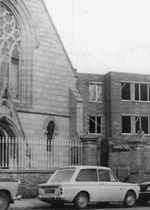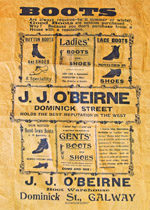Old Galway
The Jesuits in Galway (16 04 2015)

The Jesuits have been working in Galway since the early 1600’s. Even before then, men from the west of Ireland had been joining the Order. It was the policy of the Order at the time that only priests with a fluency in the Irish language would be sent to work in their native areas.
The Augustinian Nunnery (09 04 2015)

The Augustinian Friars have been in Galway since 1508 when Margaret Athy, whose husband was mayor at the time, built a friary at Forthill, near a spring called St Augustine’s Well, the waters whereof wrought miraculous cures. In O’Flaherty’s Iar-Chonnacht, there is reproduced a document in which a miraculous cure is attested to by the signatures of several witnesses.
The Barracks, Eglinton Street (02 04 15)

In 1640, on the site of this barracks, there was a three storey slated house to the front, and a one storey thatched house to the back. It was owned by Oliver Dean, an Irish papist. In 1657 it was owned by John Peters, an English protestant and was called Peter’s Plot. The police barracks was built here in 1883. It was a red brick building with a facade of 5 bays and 3 storeys and was adjacent to the Lions Tower.
The Presentation Sisters, 200 Years In Galway (26 03 2015)

In 1815, the warden of Galway Dr. French went to Kilkenny to ask sisters of the Presentation Order to return with him to Galway to found a convent here. A Reverend Bartholomew Burke has left a fund of £4,800 for the purpose. Three sisters arrived here in October of that year. They moved into a house in Kirwan’s Lane temporarily, and from there to Eyre Square. On March 25th, 1819, they moved to a house in poor condition that had originally been built as a Charter School and which would become known as the Presentation Convent. The following year they opened their school adjacent to the convent.
Cobblers And Shoemakers (19 03 2015)

The 1651 map of Galway shows a Shoemakers Tower located in what is the Eyre Square Shopping Centre today. Shoemaker’s Lane or Bóithrín na Sudairí, the road of the shoemakers or the tanners was where Buttermilk Walk is today. Shoemaking was always an important business but the individual shoemaker is a rare breed now, instead you associate the craft with factories like Dubarry in Ballinasloe.
The Head of the River (12 03 2015)

In 1976, a group of like-minded people got together to work out a way to make the sport of rowing in Galway more competitive. They decided the best way to achieve this was to set up a new club and so, Tribesmen Rowing Club was formed. Starting a new rowing club is an expensive business so they began a number of fundraising activities, running raffles, organising dances etc. They managed to get their first crew on the water in 1977.
Remembering Máire Stafford (05 03 2015)

Máire and Seán Stafford were a touchstsone of Irish Language Culture in this city for over 60 years . They each had many and different talents and when they were together, they made a formidable team. They were always together. It took him a whole three weeks after he met her to ask him to marry him. They kept Connradh na Gaeilge going for years, they kept Feis Ceoil an Iarthar going for years, they kept Féile Drámaíochta na Scoil going for years, they were the mainstay of An Taidhbhearc from 1950 for many years, their contribution to the quality of life in Galway was immense. They also reared a very talented family, many of whom were on the stage for the first time while still in their mother’s womb.
The Winter Tram (26 02 2015)

This photograph of a single-deck horse drawn tram was taken in Eyre Square c1900. The American style dome roof top cover provided cover for passengers during the winter. In one of their books, Somerville and Ross described these vehicles thus: ‘The little one-horse trams glide along the shining desolate road like white-backed beetles’. This tram was painted in a battleship grey colour. The double-deck open summer trams, which needed two horses to pull them, were painted in olive-green and white.
.png)